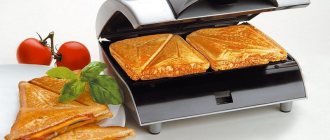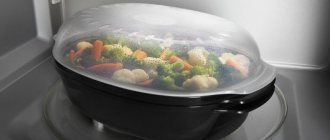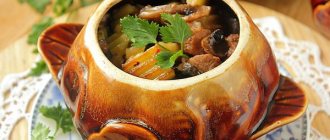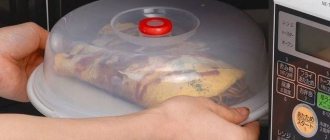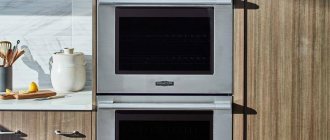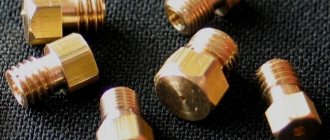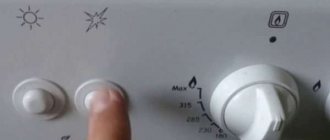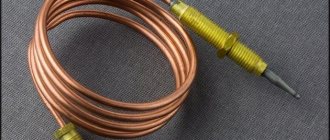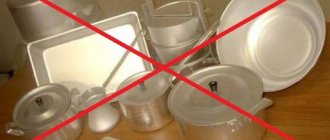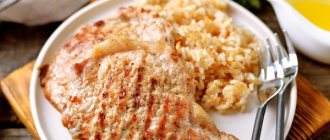Dishes are the main kitchen utensils of the housewife. The choice depends on many factors - the composition of the family, preferences in cooking and the features of the stove in the kitchen.
Standard gas stoves have been replaced by glass-ceramic hobs.
When visiting a store, a woman is puzzled by the variety of choices and, as a rule, wonders which cookware can be used on a glass-ceramic stove and which one is not worth looking at.
Glass-ceramic hobs, their capabilities and varieties
Glass ceramics is a relatively new material used in the production of cookers. Melting glass in a special way gives the surface a very beautiful appearance and special technical characteristics. Thanks to these properties, the hob is resistant to mechanical damage and tolerates temperature changes well.
Their design can complement any kitchen interior.
The glass-ceramic surface is very easy to care for; just wipe the surface with a cloth and a cleaning agent. Manufacturers do not recommend using cleaning products containing abrasives; it is better to purchase special compounds for such panels.
In addition to appearance, glass-ceramic hobs have a number of features and advantages.
Cookers with glass-ceramic surfaces are equipped with different types of heating elements: conventional pancake and double-circuit with an electric heating element, which allow you to adjust the heating diameter depending on the shape of the bottom of the pan. Also, this type of stove uses induction, which saves electrical energy.
The main feature of the stove is the vertical heating of the surface; all the heat is transferred to the dishes and is not wasted, which significantly saves the housewife’s time preparing dinners.
Those who have already purchased such equipment are wondering - what kind of cookware is suitable for a glass-ceramic stove?
It can be a built-in flat panel or complete with an oven of different volumes from 40 to 80 liters and a variety of functions that make it possible to grill in the oven. Cookers with mechanical adjustment or touch control panel, which is equipped with a variety of additional functions for ease of cooking.
The type of stoves with a glass-ceramic surface is classified as electric kitchen equipment.
Convenient functions of modern glass-ceramic panels
- Thermostats. Allows you to maintain the set temperature and cooking time that are necessary for preparing dishes.
- Heating zone. The adjustment ensures uniform heating of the cookware depending on the size and shape of the bottom.
- Safety system. Eliminates the possibility of accidentally turning on the heating element by blocking it if little naughty creatures live in the house - this function is especially necessary.
- Automation. Significantly saves time on cooking. On the display you can select the cooking product, its weight and the optimal cooking temperature, the stove will beep when everything is ready.
- Boiling function. The stove automatically reduces the intensity of the heating element when the cookware reaches boiling temperature, this will protect the panel from “escaping” soup, and the housewife from washing the surface.
They differ from their electric counterparts in their perfectly smooth surface and external designation of the burners.
Manufacturers offer a wide selection of models that can be purchased depending on preferences: a number of burners with different heating elements, complete with an oven and a different set of functions.
The stove heats the bottom of the kitchen utensil, due to which the heat is subsequently evenly distributed throughout the entire container.
Types of hobs
The material of the cookware is selected depending on the type of hob. The coating of all glass-ceramic plates is the same (the composition includes quartz sand), only the heating elements differ.
Electric hob
The following elements can be used to heat the bottom of the cookware:
- corrugated metal tapes;
- halogen lamps (rarely).
Heat flows first to the glass-ceramic surface, and through it to the bottom.
Unlike gas burners, tape and halogen heaters provide a quick temperature rise and operate only at full power. Adjustment of the cooking mode (“high”, “low” or “medium” heat) occurs by periodically turning the elements on and off.
Therefore, utensils made of low-melting metals (copper, aluminum) without a protective coating are not suitable for such stoves.
Suitable materials for electric hob:
- stainless steel;
- aluminum with ceramic or Teflon coating;
- heat resistant glass.
Glass containers do not conduct heat well. You can use them for cooking on an electric stove, but the electricity consumption will increase. The ideal option is to choose dishes with a steel bottom and glass walls.
Induction hob
A high-tech and expensive type of hobs for stoves. Under the glass-ceramic surface there is an induction coil that interacts only with metals that have ferromagnetic properties. Upon contact, eddy currents are formed, heating the bottom.
We recommend: Which heating battery is better: cast iron or bimetallic radiators, main characteristics and selection tips
If you put your hand directly to the burner that is on, you will not get burned. This is the main advantage of induction cookers. Also, the coil does not interact with liquids or food debris, which eliminates the formation of soot and greasy deposits.
However, an induction ceramic hob is demanding when it comes to cookware. Typically, manufacturers mark suitable pots and pans with a special icon in the form of a horizontal spiral.
The following materials are completely useless for use on an induction cooker:
- copper;
- aluminum;
- ceramics;
- heat-resistant glass;
- brass.
Other types of cookware are suitable provided that their bottom is made of ferromagnetic metals.
How to choose quality glass ceramic cookware
An electric stove with a ceramic coating is especially demanding when it comes to choosing suitable kitchen attributes; for all its reliability and excellent performance, incorrectly selected kitchen utensils can ruin the panel.
Upon completion of use, the surface of the panel cools quickly.
Many stove models are equipped with compatibility sensors; if you place unsuitable cookware on the surface, it simply will not heat up.
If you used a gas stove before purchasing a ceramic panel, then all kitchen utensils will have to be replaced. Glass ceramics require a perfectly flat bottom of pots and pans, and open fire, although slightly, deforms it.
Modern stove models can change the shape of the burners, which allows the consumer to use cookware of any shape.
When choosing, follow several recommendations:
- Buy products from trusted stores that sell products from major suppliers.
- Pay attention to the markings on the cookware; they should match the type of stove you have and the heating element installed there.
- Self-respecting manufacturers provide a guarantee for products of at least 24 months, this gives you confidence that this is a quality product.
The ideal bottom of the cookware should be smooth, without the slightest scratches or chips.
What cookware is not suitable for glass ceramics?
If you previously had a gas stove in your kitchen, we hasten to disappoint you: most of the pots and pans will have to be thrown away, taken to the country or given to friends.
So, what kind of cookware bottom is not suitable for glass-ceramic stoves?
- Uneven
Air gaps form between the glass-ceramic panel and the curved surface of the container, so the dishes are heated unevenly. Electricity consumption and cooking time increase.
Fire from gas burners quickly deforms the bottom of pots and pans. Unevenness also occurs due to traces of burnt fat. Therefore, old kitchen utensils are not suitable for use on a glass ceramic hob.
- Shershav
Cracks, chips, and patterns on the bottom scratch the ceramic plate, which leads to deterioration in appearance and rapid failure of the heating elements.
- Copper or aluminum
Copper and aluminum are soft metals. When the electric cooktop heats up, they melt and leave marks on the stove that cannot be cleaned. The bottom becomes uneven.
- Small diameter
Such utensils include small saucepans, cauldrons and frying pans with a round base. The food in them does not warm up, and electricity is wasted.
Utensils according to the compatibility of the panel with the material of the utensil
When buying a new stove, housewives often change pots and pans, and wonder whether it is possible to put ceramic dishes on a ceramic stove?
You can set a certain heating power of the burner, and it will increase or decrease its power independently.
Depending on what heating elements your stove is equipped with, you need to choose cookware; now manufacturers put compatibility markings on their products, which will allow you to navigate the variety of types.
As a rule, cookware for classic stoves is more varied than for induction glass-ceramic models.
The main thing is that if you have a combination model, choose dishes that can be combined with different heating elements. The best choice would be metal cookware that is compatible with induction and electric heating.
When choosing a particular cookware, you should pay attention to the features of the production material, functionality and bottom thickness.
Glass ceramic cookware: which one is suitable?
Glass ceramic cookware must meet a number of requirements.
Materials
The choice of frying pan or saucepan directly depends on what heating element is installed in the stove.
Standard glass-ceramic panels are equipped with spiral heaters that can heat containers made of any materials with a flat bottom; the use of some is simply not recommended by manufacturers.
Recommended utensils:
- enamel saucepans equipped with special markings;
- containers made of heat-resistant glass (Luminarc, Berghoff);
- containers made of steel, cast iron.
Induction models are equipped with induction coils; they heat not the burner, but the dishes, or rather, their bottom. Devices can only heat products that have magnetic properties, otherwise the device will not work. These include steel and cast iron.
To select the right cookware, you should use a magnet: if the bottom of the pan is magnetized, you can use it on the induction panel.
Cast iron objects (frying pans, casserole dishes) should be used with caution. This is because the material is quite heavy and has high thermal conductivity. The product may damage the hob, leaving a crack or scratch. And the ability to stay hot for a long time can lead to the device turning off.
Read more ► Find out which oven cleaning is best: catalytic, hydrolysis or pyrolytic
Pots with an enamel coating are recommended for use in one case: if they are equipped with special markings.
Bottom
Another important factor is the flat bottom of the pan. On gas stoves you can use containers with any relief on the bottom; this is unacceptable for glass-ceramic panels. Heating requires direct contact with the bottom surface of the container.
Kitchen utensils that have been used on gas burners for a long time are often subject to deformation, so for a new stove you will have to purchase a new set of dishes with perfectly flat bottoms.
Required diameter
Another factor is choosing the right container size. For quick cooking, the dimensions of the bottom must match the dimensions of the burners. The volume of the vessel should not be too large; the edges of the saucepan should not protrude beyond the edges of the burner.
Types of cookware by materials for ceramic surfaces
- Stainless steel. Beautiful kitchen utensils that do not require special care, and the double bottom with which the dishes are equipped does not deform, which is important for a ceramic surface. It has excellent heat-conducting characteristics; stainless steel cookware is suitable for any heating elements.
- Aluminum. The product is very light, and thanks to the non-stick coating, you can cook any food on it without fear of burning. Ceramic dishes are used with a metal bottom and various coatings, it can be Teflon, ceramics or enamel. To be able to use it on induction, it is equipped with a special magnetic bottom; such cookware will cost a little more than its counterparts for conventional stoves.
- Cast iron. Ideal for all types of stoves, but it is heavy and the delicate ceramic coating can be scratched, so use a large cast iron cauldron for cooking pilaf with caution. But the high thermal conductivity of metal and its inability to deform go well with ceramics; dishes will be cooked as quickly as possible.
- Glass. It is acceptable to use glassware on electric heating elements, but it is not suitable for induction. If you love glass utensils and don’t want to give them up, purchase models with a built-in magnetic bottom. Glass has low thermal conductivity, and the metal bottom on the product will allow you to cook in a saucepan much faster, and it will also be induction compatible.
- Ceramics. Not a good choice for your stove. Some types of panels may simply not react to ceramics and not heat them up. If you love this material, then purchase metal copies with a ceramic coating, then it will fit any heating element.
- Enameled. Dishes that we have long been accustomed to and love to use. Every housewife will appreciate the beautiful design and safety when preparing and storing ready-made dishes in an enamel saucepan. It is perfect for your stove, but when purchasing, pay attention to the thickness of the bottom, it should be at least 3 mm; specimens with a thin bottom will quickly deform when heated quickly and will have to be abandoned from further use.
- Teflon. The cookware is made of metal alloys and coated with Teflon. Often Teflon models are made from aluminum, which is suitable for electric stoves, and induction heating elements will not heat them.
Suitable cookware material for glass-ceramic stoves is stainless steel with a double bottom, enameled or cast iron kitchen utensils, which are suitable for any model.
Soft metal products such as copper and brass are absolutely not suitable for use on a stove that is completely heated.
Which dishes should I choose?
The most important rule:
The volume of the bottom of the dish should completely cover the heating circle, and ideally, be a little more, but not less. This, as you remember, is to ensure that the surface is protected from moisture.
Then, dishes for glass-ceramic stoves should be made of steel, cast iron or enameled metal. But its bottom must certainly be flat, even and smooth. The best option is if it is heavy and thick.
In general, stainless steel cookware is considered the best option for glass ceramics. It is not as heavy as cast iron, which is additional insurance in case of a fall, and it has good thermal conductivity.
Yes, and such pans are easy to wash, but the glass-ceramic hob has nothing to do with it, of course.
See also -
What is the optimal power of an induction hob?
Other Compatibility
- Bottom. It should be thick, without reliefs or bulges with minimal reflection effect. If your stove has conventional heating elements that are not adjusted to different cookware diameters, then it would be better to purchase a set of kitchen accessories according to the size of the burners. On induction models, with a small bottom of the pan, less than 14 cm in diameter, it is recommended to use a special overlay on the burner, which ensures contact between the surfaces.
- Volume and size and wall thickness. It doesn't matter, the glass ceramic hob will heat any pan in no time.
- Type of lid and handle. The peculiarity of this stove is that it heats only the bottom, so which lid you choose is up to you; the handles are made of heat-resistant plastic, with the exception of cast iron cookware, which is not affected by any heating elements.
Since the principle of operation is aimed at interacting with the bottom of the vessels, their compatibility will directly depend on the bottom of the kitchen utensils.
What are the features of heating dishes for glass-ceramic hobs?
A distinctive feature of such hobs is the rapid heating of the burners, which release thermal energy vertically only to the bottom of the cookware. And quick cooling of the surface will protect your family and especially small children from burns. If an induction heating element is installed on the stove, it does not heat the surface of the hob, but only interacts with the cookware. This is the safest stove on the household appliances market.
Modern manufacturers have begun to produce aluminum products with a specialized magnetic bottom, which allows the cookware to be fully used on such panels.
What cookware should not be used on glass-ceramic surfaces?
When purchasing, you need to know: what cookware is suitable for a glass-ceramic stove and what absolutely cannot be used.
It is prohibited to purchase and use vessels made of fragile materials. Thin-walled products heat up quickly and there is a risk that they will melt.
Characteristics of kitchen utensils that are unacceptable for glass ceramics.
- Dirty and rusty bottom surface, which will stain and scratch the glass ceramics. Stains can still be dealt with, but scratches are a violation of the integrity of the surface on which cracks may appear.
- Pure soft alloys without non-stick coating, aluminum and copper frying pans or pans, when heated, interact with the surface and leave stains on it that cannot be removed with anything and your hob will lose its beautiful appearance forever.
- Kitchen utensils with deformed or embossed bottoms and items with engravings on the bottom. The surface should be as smooth as possible, matte or dark in color, then you will ensure better interaction between the hob and cookware, which will significantly save energy and time on cooking.
- The walls of kitchen utensils that expand upward, for example, a wok, are unacceptable. A small bottom, in relation to the area and volume of the entire surface of the pan, will not heat the food.
Modern stove models are distinguished by high power and heat transfer.
General bottom requirements
As you may have already noticed, the bulk of the requirements are placed on the bottom of the cookware for ceramic electric stoves. Below you will find out what points you should pay attention to so that the device serves you for a long time.
- Surface
The ideal bottom of glass ceramic cookware is flat and smooth. A concavity in a cold state of no more than 0.6% of the diameter is allowed. When heated, the bottom expands slightly and fits tightly to the surface of the stove.
Any irregularities and roughness lead to poor heat transfer to the dishes. The electric stove overheats, which leads to a reduction in service life, and energy consumption increases.
Typically, cookware for glass-ceramic hobs is treated with a protective compound that prevents scratches, bends, and gouges.
- Thickness
The thicker the bottom, the better. You've probably noticed how quickly food, especially liquid food, burns on thin aluminum pots and pans. Therefore, you need a thick bottom that will heat evenly and will not deform due to high temperature.
As a rule, the bottom of a pot for a ceramic stove consists of 3-5 layers of different metals: stainless steel, aluminum alloy. This increases strength and improves heat distribution.
- Color
The light, glossy surface reflects heat radiation, which increases cooking time and electricity consumption. The bottom of glass ceramic cookware should be dark and matte.
- Diameter
If you are selecting dishes for an electric stove, then keep in mind that the diameter of the bottom of the pan (frying pan) must fully correspond to the diameter of the burner. Using kitchen utensils with a small bottom leads to problems - wasted energy consumption, overheating of the electric stove and the danger of getting burns from touching an open hot surface.
Pots and pans with a bottom larger than the diameter of the burner do not heat up completely.
For induction appliances, a more loyal principle applies, because the coil only heats the dishes. It is desirable that the bottom matches the diameter of the burner, but it can be smaller. If you place a large frying pan on a small circle, only part of the bottom will heat up, which will increase the cooking time.
We recommend: Sliding or hinged – which wardrobe is better and what to choose to keep things in order
What problems can arise if you choose the wrong kitchen attributes for an electrical panel?
First of all, due to the rapid heating of the surface, the bottom of unsuitable dishes quickly becomes deformed, and this threatens you with throwing out your favorite saucepan and overheating the heating element. Repairing such equipment is a very expensive procedure. When using soft alloys, you will forever leave sloppy stains on the surface that cannot be removed. Due to the use of very heavy and massive kitchen utensils, the likelihood of cracks and chips in the coating increases; you can use such stoves, but they will not last you long.
Using existing or purchased steel or cast iron cookware, you definitely won’t go wrong and won’t damage the glass-ceramic hob.
What can happen if you choose the wrong kitchen utensils?
Inappropriate or irrational selection of kitchen utensils affects the condition of the stove, both external and internal. Chips and resulting dirt damage the material of the hob. The presence of a gap between the bottom and the panel increases energy costs.
The performance of the panel is affected by uneven bottoms of the pans. This negatively affects the shelf life of the hob and its technical characteristics. First one burner does not work well, then the second. Subsequently, the entire slab will need expert evaluation and repair.
The shelf life of the equipment that surrounds the owners depends on the care and attitude towards the devices. You need to know what cookware is suitable for an induction or electric hob, what materials for utensils are allowed, and how and with what to clean the products.
When you discover the first malfunction, you should contact a technician. He will point out existing problems and errors in use, and give clear recommendations for operation that will keep the equipment in excellent condition.
Useful tips for the care and use of glass ceramic cookware
In order for your cookware to prepare tasty and healthy dishes and to please you with its appearance, you need to take proper care of it.
A black matte bottom heats up better than a glossy and light one.
A few tips that may be useful to the hostess.
- When purchasing new dishes, they must be thoroughly washed with a mild detergent and dried before use.
- Keep kitchen utensils clean, this is especially important for glass-ceramic cooktops.
- Do not use abrasive cleaners that will scratch the surface. Products with a non-stick coating are especially sensitive to abrasives; scratches form on the surface, and such cookware can no longer be used for cooking. The stainless steel pan will become dull and lose its shiny surface.
- When cleaning surfaces, it is better to use folk care products. Baking soda and mustard powder, which are also suitable for your hob, are excellent for cleaning almost all contaminants.
- Do not leave empty dishes on the stove; overheating is dangerous not only for your saucepan, but also for the stove. It is advisable that the pan be filled with food to 2/3 of its volume.
- Avoid placing a wet bottom of a pot or pan on a hot burner; ceramics are a resistant coating, but such contact may cause microcracks to form, which reduce the life of the hob.
Some modern models simply do not turn on when there are inappropriate dishes on their surface. These include: glass, aluminum, brass objects.
By choosing the right kitchen accessories in the store, you will use your favorite saucepans for a long time and will not damage the beautiful surface of the glass-ceramic panel.
Before purchasing a glass-ceramic vessel, read useful information in online resources or consult with the seller before purchasing.
